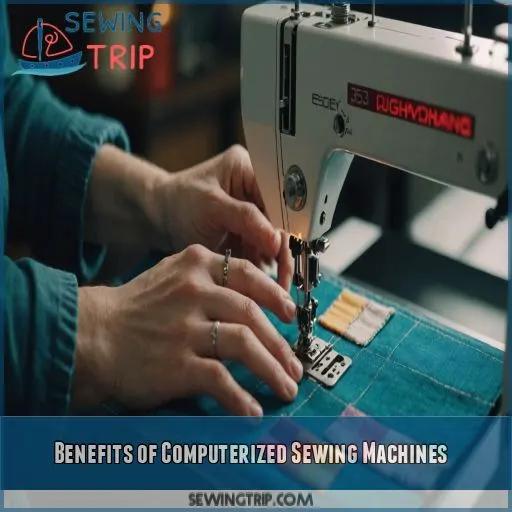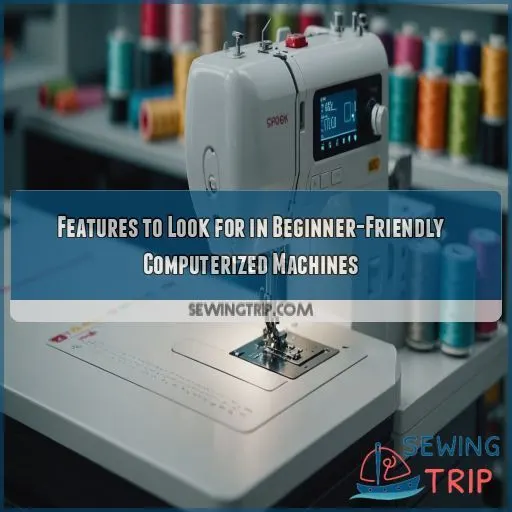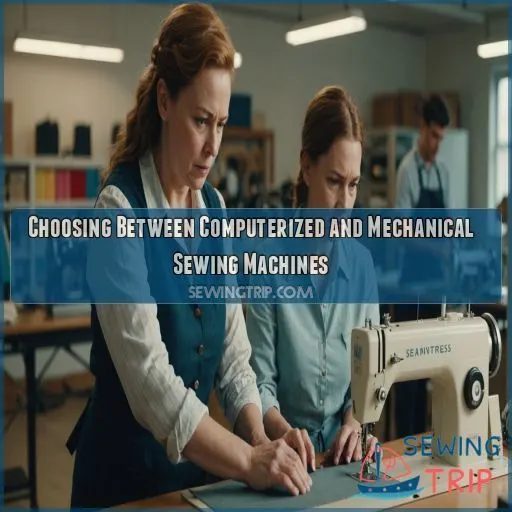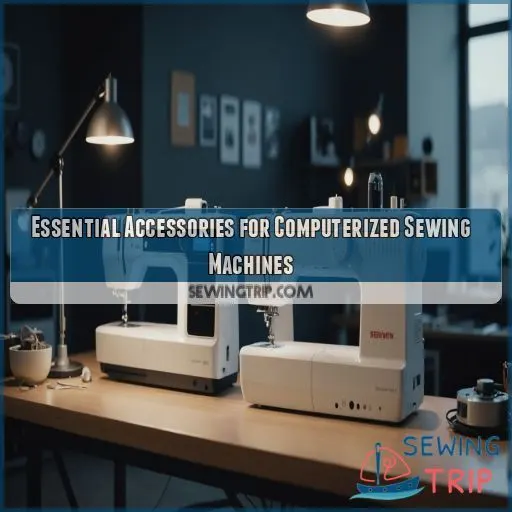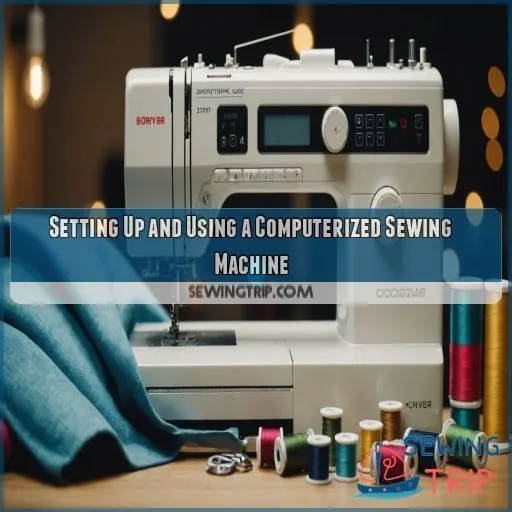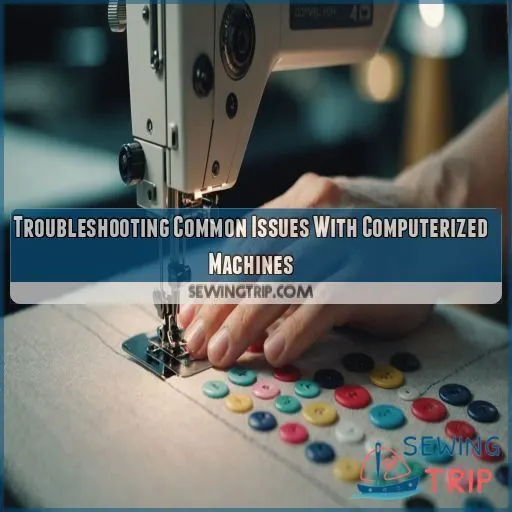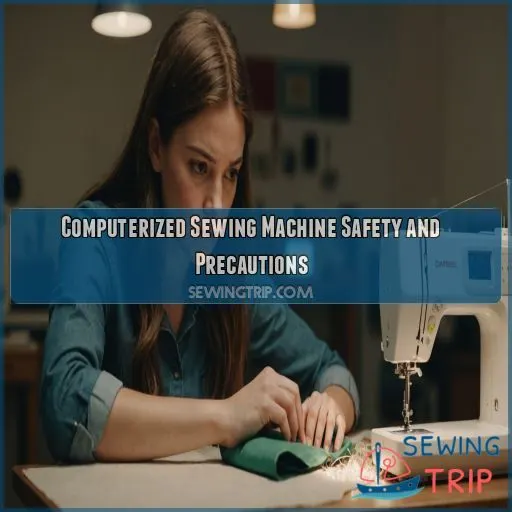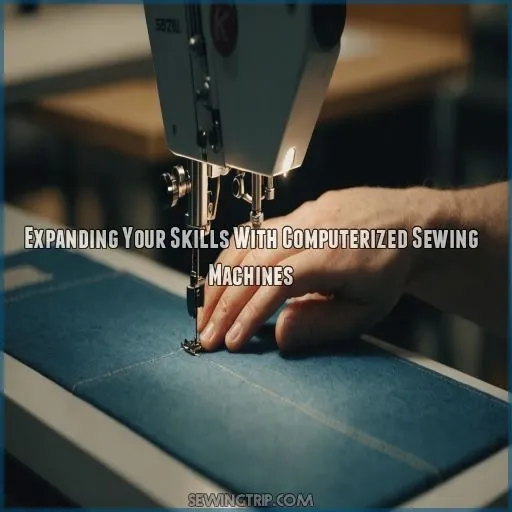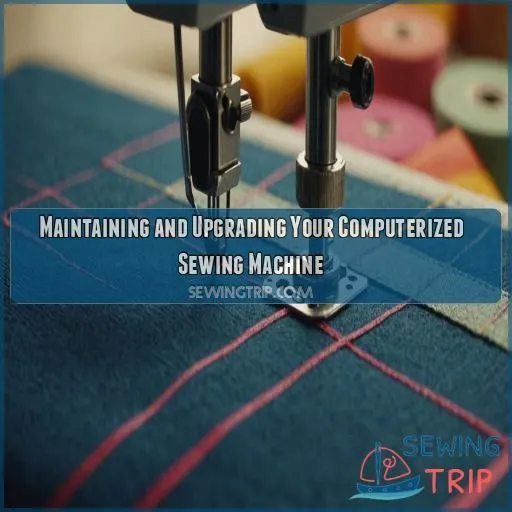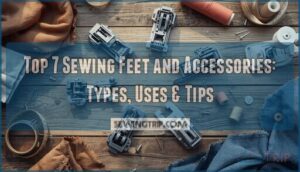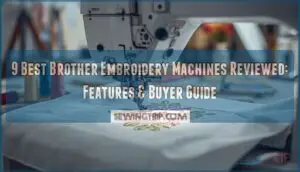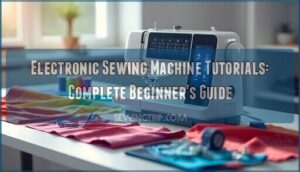This site is supported by our readers. We may earn a commission, at no cost to you, if you purchase through links.
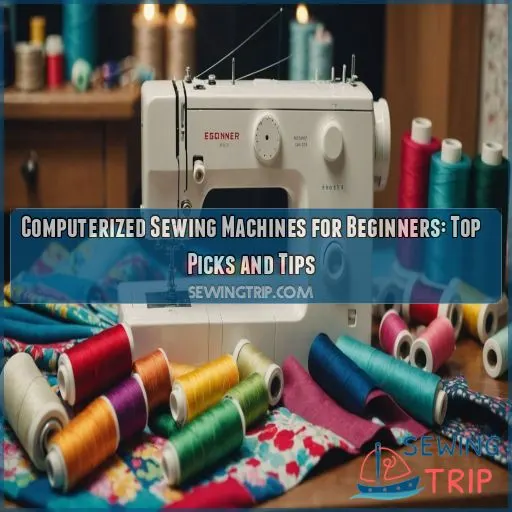 Embracing the sewing journey with computerized sewing machines for beginners can feel like a leap into sewing mastery.
Embracing the sewing journey with computerized sewing machines for beginners can feel like a leap into sewing mastery.
These machines are as friendly as your favorite neighbor, offering easy-to-use interfaces and magical auto-threaders that’ll keep knots away.
You’ll love exploring endless stitch options, transforming your fabric into creative masterpieces.
Wondering if you can handle it? Absolutely! Choosing a computerized sewing machine is like picking a sidekick that’s got your back with intuitive controls and precise stitching.
Sewing won’t just be a task; it’ll be your latest obsession.
Ready for some crafty secrets that could take your skills up a notch? Stay tuned!
Table Of Contents
- Key Takeaways
- Benefits of Computerized Sewing Machines
- Features to Look for in Beginner-Friendly Computerized Machines
- Choosing Between Computerized and Mechanical Sewing Machines
- Top 3 Computerized Sewing Machines for Beginners
- Essential Accessories for Computerized Sewing Machines
- Setting Up and Using a Computerized Sewing Machine
- Troubleshooting Common Issues With Computerized Machines
- Computerized Sewing Machine Safety and Precautions
- Expanding Your Skills With Computerized Sewing Machines
- Maintaining and Upgrading Your Computerized Sewing Machine
- Frequently Asked Questions (FAQs)
- Conclusion
Key Takeaways
- Computerized sewing machines are your friendly neighborhood helpers, making sewing easy with features like automatic needle threaders and a wide range of stitch options. Think of them as your creative sidekick that turns sewing into a fun obsession.
- They’re packed with advanced features such as precise stitch control and intuitive interfaces – it’s like having a GPS for your sewing journey, helping you avoid any rocky roads and enjoy a smooth, enjoyable experience.
- Don’t worry about being a beginner; these machines are as approachable as a warm cup of cocoa on a rainy day. They guide you through complex tasks with ease, making you feel like a sewing wizard in no time.
- Whether you’re sewing delicate silks or thick denims, computerized machines handle a variety of fabrics like a champ. Just adjust your settings, choose the right needle, and you’re ready to make fabrics dance like nobody’s watching.
Benefits of Computerized Sewing Machines
You know, computerized sewing machines are like the swiss army knives of the sewing world—they offer tons of options and make stitching a breeze. With these machines, you’ll find automatic needle threaders, precise stitch control, and the ability to work with various fabrics, letting you express your creativity effortlessly.
Increased Stitch Options
Computerized sewing machines open up a world of creative potential with increased stitch variety. Imagine the project possibilities! Here’s why you’ll love it:
- Stitch Customization: Tailor designs to your taste.
- Decorative Stitches: Add flair effortlessly.
- Automatic Buttonhole Making: Simplify complex tasks.
Automatic Needle Threaders
Imagine this: threading a needle without squinting or frustration. That’s the magic of an automatic needle threader. It’s a handy feature, especially for beginners. No more pesky threader problems or guesswork—just smooth, effortless sewing on your computerized sewing machine.
Precise Stitch Control
With a computerized sewing machine, you’ll enjoy precise stitch control, ensuring:
- Consistent stitches for professional-looking results
- Accurate seams for perfect garment construction
- Effortless fabric handling, even for delicate materials.
Versatility in Fabric Manipulation
How often do you wrestle with tricky fabrics like a cat with yarn? Computerized sewing machines tackle that challenge by offering stitch control, free-motion quilting, and drop-feed systems, making light fabrics flow and heavy ones dance effortlessly under your command.
Features to Look for in Beginner-Friendly Computerized Machines
When you’re starting out with sewing, finding a user-friendly machine is like having a GPS on a road trip—essential for avoiding wrong turns. Look for features like intuitive controls, drop-feed systems, and easy stitch adjustments to keep your sewing journey smooth and enjoyable.
Ease of Use
When diving into computerized sewing machines, you’ll find ease of use is paramount. Look for a user-friendly interface that simplifies stitch selection. Using the controls shouldn’t feel like deciphering a mysterious codeembrace reliable brands offering a gentle learning curve!
Intuitive Interfaces
Look for computerized sewing machines with intuitive touchscreens, visual guides, and simplified menus. These user-friendly features make it a breeze to navigate the machine’s functions, even for sewing newbies.
Drop-Feed Systems
You’re exploring intuitive interfaces, and here’s where the drop-feed system shines in computerized sewing machines. This nifty feature lets you quilt like a pro by lowering feed dogs, allowing free-motion magic. Beginners will find it liberating yet manageable!
Stitch Selection and Adjustment
After mastering drop-feed systems, stitch selection and adjustment is your next sewing adventure. Imagine customizing stitches like a chef spices a dish. Look for:
- Stitch types: Versatility at your fingertips.
- Stitch length/width: Adjust with ease.
- Stitch tension: Perfect balance.
Choosing Between Computerized and Mechanical Sewing Machines
Choosing between computerized and mechanical sewing machines might feel like comparing apples to oranges, but don’t worry—it’s easier than picking a pattern for your first quilt choosing a sewing machine! You’ll find that computerized machines offer convenience and advanced features, while mechanical ones provide simplicity and reliability, ensuring there’s a perfect match for every budding sewist.
Mechanical Machines: Basic, Yet Effective
Mechanical machines are a basic, yet effective option. They rely on dials and knobs, requiring more manual adjustments but offering a simpler learning curve and budget-friendly price tag. Consider a mechanical machine if you prioritize simplicity and cost-savings.
| Pros | Cons |
|---|---|
| Simple operation | Fewer stitch options |
| Easy repairs | Less automation |
| Budget-friendly | Steeper learning curve |
| Durable construction | Limited fabric control |
| Ideal for beginners | Fewer advanced features |
Computerized Machines: Advanced, With More Options
A computerized sewing machine opens up a world of possibilities with stitch control, embroidery features, and advanced needle threading. You’ll master fabric handling effortlessly, like Picasso with a paintbrush, using sewing fonts and features designed for different needs.
Considerations for Beginners
When you’re dipping your toes into the sewing world, balance budget with features. Computerized machines offer fancy extras, but mechanical models can keep life simple. Prioritize ease of use; like a friend, reliable brands and honest reviews will guide you.
Choosing the Right Machine for Your Needs
Understanding your needs is like finding the right shoe fit. A mechanical machine offers simplicity, while a computerized counterpart opens a vault of features. Consider your budget and sewing projects—are you crafting quilts or stitching denim? Choose wisely!
Top 3 Computerized Sewing Machines for Beginners
If you’re just starting out with sewing, the right computerized machine can make all the difference. Check out our top three beginner-friendly picks that offer user-friendly features to get you stitching with confidence.
1. Brother CS7000X Sewing Quilting Machine
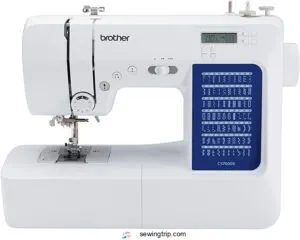
Are you ready to conquer the sewing world? The brother cs7000x is a great choice! It’s like having a sewing guru in your corner! With 70 built-in stitches, you’ll have more options than toppings on a pizza. The automatic needle threader saves time – no more squinting! Explore quilting with ease using the included wide table. Though in dim lighting, the work light is as dim as Monday motivation, but with a compatible extension cord, you’ll sew like a pro in no time.
Best For: The Brother CS7000X is best for beginner to intermediate sewers who want a versatile machine with a wide range of stitches and a helpful automatic needle threader.
- 70 built-in stitches for diverse sewing needs
- Automatic needle threader for quick and easy threading
- Wide table for quilting projects
- Dim work light can be frustrating in low-light conditions
- Buttonhole attachment markings are difficult to read
- Maximum speed of 750 stitches per minute may not be fast enough for experienced sewers
2. Janome 3160QDC Sewing Quilting Machine
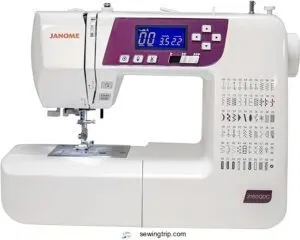
Say hello to the Janome 3160QDC, your trusty sidekick on the quilting adventure. It’s got your back with computerized features and an LED control panel that makes you feel like a sewing wizard. With everything from stretch stitches to decorative options, it’s like having a Swiss Army knife for fabrics. Prone to thread jamming? It might act up occasionally, but it’s nothing a little wizardry can’t fix. At $550, it’s an investment, but oh what seam-tacular surprises await!
Best For: The Janome 3160QDC is best for quilters who need a reliable and feature-rich machine.
- Computerized features make sewing easier and more precise.
- The machine is equipped with a variety of stitches, including stretch stitches and decorative stitches.
- It has a metal internal frame and metal gears for durability.
- Some users have reported issues with thread jamming and automatic threader.
- The machine is expensive.
- The machine can be difficult to transport due to its size.
3. Juki TL 2010Q Sewing Quilting Machine
The Juki TL 2010Q is like a trusty sidekick for sewing enthusiasts ready to jump into quilting. With its heavy-duty design, its perfect for handling delicate fabrics and thick seams. Sure, threading might feel like a dance at first, but dont worryyoull find your rhythm. And while daily oiling sounds messy, its a small price for those precise, whisper-quiet stitches. Remember, even superheroes face a learning curve! Embrace the challenge and open up a world of creative potential with this machine.
Best For: The Juki TL 2010Q is best for quilters and sewists who need a heavy-duty machine for both delicate and thick fabrics.
- Handles both delicate fabrics and thick seams with ease.
- Delivers precise and consistent stitches with whisper-quiet operation.
- Comes with a thread cutter and thread cone compatibility for larger projects.
- Threading and bobbin loading can be challenging for beginners.
- Requires daily oiling, which can be messy.
- Feet are not compatible with basic sewing machines, and swapping them out can be difficult.
Essential Accessories for Computerized Sewing Machines
When you’re starting with computerized sewing machines, having the right accessories like walking feet and free-motion quilting feet can make all the difference. They might sound like fancy dance moves, but trust me, they’ll help your projects glide along smoothly!
Walking Feet
After exploring the top sewing machines, you’ll find walking feet to be your trusty sidekick when buying a sewing machine. These handy attachments manage tricky fabrics, like a sherpa herding sheep. Adjust foot pressure for various tasks, ensuring smooth sailing across different applications.
Free-Motion Quilting Feet
Free-motion quilting feet let you explore your creativity! Glide smoothly over fabric, sculpting intricate designs. Adjust foot pressure for perfect control. Elevate your quilting game with this versatile accessory. Get started and let your imagination soar!
Zipper Feet
Unzip the mystery of sewing zippers with ease! Zipper feet are game-changers for your sewing journey. Here’s why:
- Variety: Different types suit unique projects.
- Precision: Allows sewing close to zipper teeth.
- Versatility: Fits multiple machine models.
Overlock Feet
If you’re into sewing, an overlock foot helps you sew with a pro’s finesse. It neatly finishes seams, adding a polished touch. Explore types and uses in this table, and kickstart your journey!
| Foot Types | Benefits | Tips for Use |
|---|---|---|
| Standard | Perfect seams | Start slow, go steady |
| Rolled | Elegant narrow edges | Use lightweight fabric |
| Elastic | Stretches with fabric | Ideal for sportswear |
| Gathering | Ruffles aplenty | Practice makes perfect |
| Blind Hem | Invisible finishes | Adjust tension carefully |
Setting Up and Using a Computerized Sewing Machine
Setting up a computerized sewing machine can feel like opening a box of mystery, but don’t worry, it’s easier than you might think. With a little patience and a splash of humor, you’ll master threading, bobbins, and all those shiny buttons in no time.
Unpacking and Assembly
When unboxing your new sewing machine, you’ll feel like a kid unwrapping a birthday present. Carefully remove the packaging, following the instructions for setup. Keep safety in mind, and gather any tools you might need for assembling your machine.
Thread and Bobbin Preparation
Thread types can make or break your sewing dream! Start by choosing quality thread for smooth sailing. Don’t let bobbin winding be like winding a ball of yarn. Follow these steps:
- Make sure the bobbin is in the right place
- Handle tension issues patiently
- Master threading order
- Utilize the thread cutting feature
- Choose the right sewing machine needle
Navigating the Interface
You’ve got your thread and bobbin ready; now it’s time to conquer your sewing machine’s interface. Think of it as your sewing machine’s control panel, where buttons become your creative allies and display screens are your artistic guideposts.
Basic Stitch Selection and Operation
When you’re learning the ropes of a new sewing machine, don’t play hard-to-get—embrace stitch settings! Explore basic stitches like zig-zag and straight. Experiment with stitch adjustment to see what suits your projects. Remember, practice makes perfect!
Troubleshooting Common Issues With Computerized Machines
Computerized sewing machines are amazing tools, but let’s face it, they can be as moody as a cat on bath day. Don’t worry, with a little patience and know-how, you’ll tackle thread tension tantrums and error code headaches like a sewing superstar.
Thread Tension Problems
Thread tension has a mind of its own, doesnt it? If youre pulling your hair out, check bobbin tension, needle size, and fabric type. A little sewing machine maintenance can help those sneaky variables behave. Keep cool; youve got this!
Incorrect Stitch Selection
So, your sewing machine is picking stitches like a kid in a candy store with two bucks? Don’t worry! Selecting the wrong stitch can make your project go haywire. Match fabric type with your stitch, and you’re golden.
Machine Malfunction or Error Messages
If you’re scratching your head at a machine glitch, don’t sweat it—technology isn’t always smooth sailing. Error messages can pop up, but they’re quick to tackle:
- Check the manual.
- Reset the machine.
- Secure connections.
- Seek online troubleshooting tips.
Regular Maintenance and Cleaning
For smooth stitching, regular sewing machine maintenance is key. Dust often. Oil lubrication, like a good joke, makes everything run better. Replace needles routinely. Here’s a simple cleaning checklist:
| Task | Frequency | Tools Needed |
|---|---|---|
| Dust Machine | Weekly | Soft brush, cloth |
| Oil Lubrication | Monthly | Sewing machine oil |
| Needle Change | Every 10 hrs | New needles |
| Thorough Clean | Monthly | Screwdriver, vacuum |
With these tips, keep your sewing machine purring like a contented cat.
Computerized Sewing Machine Safety and Precautions
Learning the safety measures of using a computerized sewing machine is as important as mastering its stitches after all, nobody wants a misplaced needle in their life. Sewing Machine Safety! Lets make sure you’re set up safely and smartly, so you can enjoy your sewing journey without any hitches or stitches to worry about.
Electric Shock Prevention
Protect yourself from electric shocks by using Ground Fault Circuit Interrupters and inspecting power outlets. Keep your sewing machine’s electrical cord in good condition, and never operate it near water. Safety first, my friend!
Needle Safety
Handling needles safely is a stitch in time. Remember to always:
- Store needles carefully to avoid prickly surprises.
- Change needle size based on fabric type: delicate, stretchy, or woven.
- Laugh in the face of a broken needle!
Fabric Handling and Control
Now that you’re a pro with needle safety, let’s talk fabric handling. Master different fabric types, adjust thread tension, and choose the right needle and foot pressure. This friendly table should clarify how to work with various fabrics:
| Fabric Type | Needle Selection | Foot Pressure | Sewing Speed |
|---|---|---|---|
| Heavy Fabrics | 16 or 18 | High | Slow |
| Light Fabrics | 9 or 11 | Low | Medium to Fast |
| Thick Fabrics | Denim/Acrylic | High | Slow |
| Thin Fabrics | 9 or Sharp 70/10 | Low | Fast |
Stay patient and flexible as you find the rhythm that works best for your sewing machine. Each project is an opportunity for freedom and creativity.
Machine Placement and Workspace Clearance
Now that you’ve mastered fabric handling, let’s talk workspace. Its not just sewingits zen! Make sure you have good lighting, ample storage, and check your ergonomic setup. A clutter-free zone ensures safety, whether you’re tackling upholstery or tailoring like a pro!
Expanding Your Skills With Computerized Sewing Machines
With a computerized sewing machine, you’ll soon find yourself stitching like a pro, exploring options beyond a basic straight line. Don’t worry about tackling new projects; think of it as your sewing superpower opening amazing possibilities, from free-motion quilting to whipping up fabulous custom designs.
Exploring Advanced Stitch Options
Now that you’re all stitched up with safety, let’s play with the fancy stitches computerized machines offer!
Try these options:
- Decorative Stitches: Add flair to any project.
- Monogramming: Personalize with ease.
- Buttonholes: Create perfect closures effortlessly.
Mastering Free-Motion Quilting
Free-motion quilting is like driving a zippy car! Choosing the right quilting foot, mastering fabric tension control, and creative design ideas are keys. Practice techniques will boost your confidence, whether it’s sewing leather or tackling tough denim projects.
| Tip | Why It Matters | Example |
|---|---|---|
| Quilting Foot | Better fabric movement | Easier curves |
| Fabric Tension Control | Smooth stitching | No puckering |
| Practice Techniques | Confidence building | Try test pieces |
| Design Ideas | Inspire creativity | Unique patterns |
| Machine Selection | Right tool for fabric | Leather or denim use |
Creating Custom Embroidery Designs
Ready to make magic with custom embroidery designs? Check out embroidery software for inspiration. Experiment with digitizing techniques and different hoop sizes. Choose your threads wisely—think of them as your design’s wardrobe. Now, go on and stitch your heart out!
Working With Different Fabric Types
Diving into fabrics? Don’t fret! Understanding fabric weight, texture variations, and stretch fabrics is key. Equip yourself with sewing techniques to tackle any material, paying attention to fabric care. Remember, practice makes perfect and funnier mistakes!
Maintaining and Upgrading Your Computerized Sewing Machine
Taking care of your computerized sewing machine can feel a bit like nurturing a beloved pet—it needs regular cleaning and the occasional upgrade to stay purring happily. Don’t worry, we’ll show you how to keep your sewing buddy in top shape without needing a PhD in engineering!
Hardware Upgrades and Replacement Parts
Upgrading your sewing machine can feel like giving an old dog new tricks! Consider these upgrades for better control:
- Replacement needles – They’re like fresh starts for your stitches.
- New bobbin cases – Smooth out those thread tangles.
- Foot options – Try new projects without fear.
Cleaning and Lubrication
Keeping your sewing machine purring like a kitten means regular maintenance. A consistent oiling schedule and cleaning tools are your best friends. Dust bunnies in the bobbin area? They’re your arch-nemesis! Preventative care eliminates common problems, ensuring smooth sewing. Remember, your machine deserves TLC—tender loving care—just like anything else.
Storage and Transportation
- Invest in a dedicated sewing machine bag or case to protect it during travel.
- Choose a lightweight model if you plan to move it frequently.
- Store your machine in a clean, dry place to prevent dust buildup.
Frequently Asked Questions (FAQs)
Can a beginner use a computerized sewing machine?
Computerized sewing machines are beginner-friendly. With intuitive controls and a range of built-in stitches, you can dive right in and start sewing up a storm. Don’t be intimidated – these machines are designed to make your sewing journey a breeze.
Are computerized sewing machines worth it?
You get what you pay for! Computerized sewing machines are worth it if you crave ease and versatility. They might sound scary to start, but they’re user-friendly and perfect for exploring creativity. Even beginners can master them!
Which is the best sewing machine for beginners?
For beginners, the Brother CS7000X is ideal. It’s like your trusty road map, guiding you through easy projects with a smile. Enjoy exploring 70 stitches. It’s the perfect companion on your sewing adventure!
Are Brother sewing machines good for beginners?
Brother sewing machines are like a trusty sidekick for beginners, especially the Brother HC1850 with its wide range of stitches. They’re simple to use, packed with features, and won’t break the bank. Perfect for tackling your first sewing adventures without losing your thread!
How long do computerized sewing machines last?
Computerized sewing machines can last 10-15 years with proper care and maintenance. Treat your machine well, and it’ll be your trusty sidekick for all your sewing adventures for years to come. Just like a good friend, it’ll be there when you need it!
Are computerized sewing machines compatible with all fabrics?
Computerized sewing machines handle a wide range of fabrics, from lightweight silk to heavy denim. Just be sure to adjust your settings and use the right needles. It’s like matching socks to your mood!
What are the costs of maintaining computerized machines?
Maintaining a computerized sewing machine doesn’t cost an arm and a leg. Routine expenses include oiling, occasional needle replacement, and servicing. Treat your machine well, and it’ll stitch happily ever after, saving you from hefty repairs.
Can computerized machines connect to smart devices?
Ever feel like your sewing machine could use a smartphone sidekick? Good news—some computerized sewing machines can connect to smart devices! This feature makes your sewing smoother by letting you download patterns and update settings seamlessly.
How much space do computerized sewing machines need?
Computerized sewing machines don’t need a ton of space – just enough room to comfortably fit the machine and allow for easy movement of your fabric. Think about your available workspace and choose a model that fits nicely without feeling cramped.
Conclusion
Starting a sewing journey can feel intimidating at first, but it’s ultimately rewarding!
It’s like teaching your dog new tricks – a challenge that leads to a sense of accomplishment.
With computerized sewing machines for beginners, you’ve got a trusty sidekick equipped with intuitive interfaces and creative solutions.
These machines transform sewing into a fun obsession rather than a chore.
Explore the realm of stitches, patterns, and fabrics.

